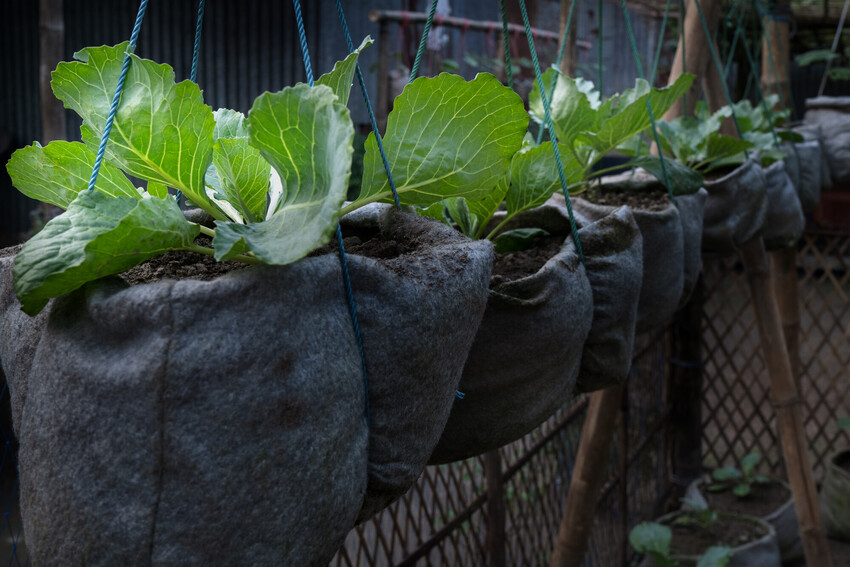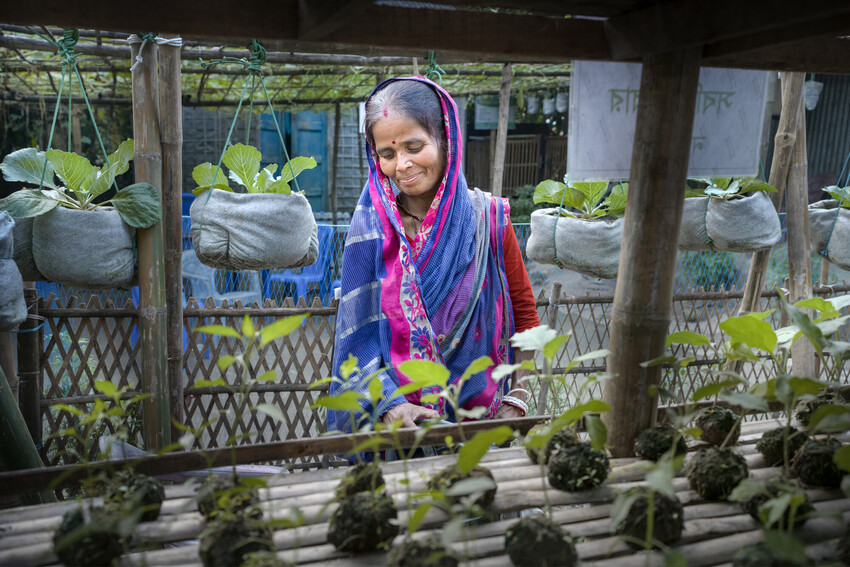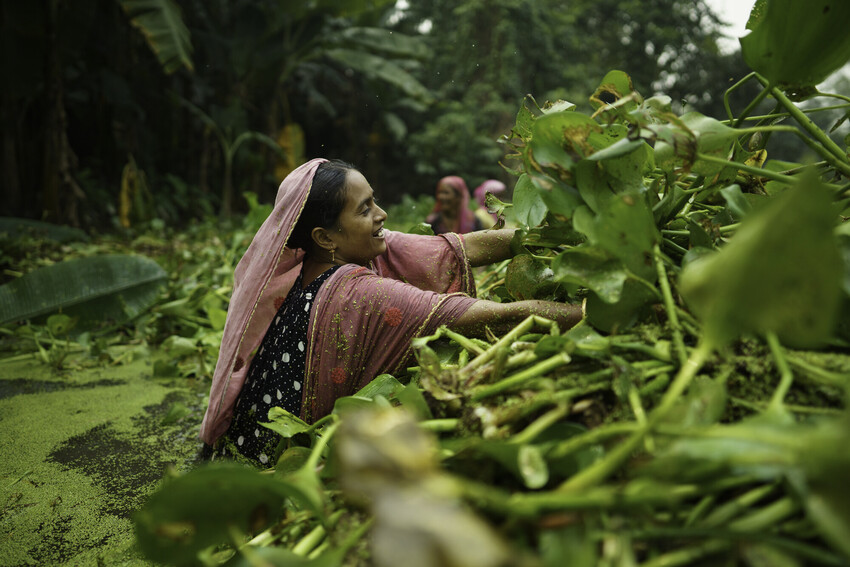More frequent and unpredictable
How climate change and flooding affect farmers in Bangladesh
Until last summer, Hena Khatun did not even try to plant vegetables on her postage-stamp-size property. Every year the floodwater from the nearby Jamuna River threatened to cover the small section of land where she lives in the northwest of Bangladesh, 30 miles (48 km) from the city of Bogura. Finding a place to call home is a fragile balance for Khatun and many others living alongside the immense river, one of the world’s largest braided rivers that can stretch up to 2.5 miles (4km) across with sandbars so large people live on them. They don’t own the land they live on, and when the floods come they have to leave suddenly, finding whatever small piece of land they can. Or they have to move elsewhere and become a climate migrant, which most people don’t want or have the resources to do.
Unfortunately, the constant cycles of flooding aren’t going away anytime soon – with climate change the rising waters are only coming more often. But how could they afford to pick up and start again somewhere new?

Flooding, drought and unpredictable seasons
Bangladesh is a low-lying country, full of rivers and waterways. This means that Bangladesh is also high on the list of countries vulnerable to climate change. Bangladesh was ranked 7th on the Global Climate Risk Index in 2021 despite ranking 175th in per capita CO2 emissions. While the southern part of the country is often in the news because of rising sea levels and increased salinity in the soil, the northern part of the country where Khatun lives is also seeing the effects of climate change.
These northern communities have experienced regular flooding for many years. But as climate change continues to worsen, rains get heavier—and the Himalayan glaciers are melting at a faster pace, making the floods more frequent and longer lasting. "If you talk with the people, they will say that earlier the flooding was one time or two times in a year, but now it is four or five times," says Arefur Rahaman, food security and livelihoods coordinator for MCC in Bangladesh. "It is happening frequently sometimes and sometimes it is unpredictable."
Each time the floodwaters rise, families are uprooted and must rebuild their homes and livelihoods from scratch. Flooding also can wash away belongings and livestock.
Nikhil Chandra Mondol and his wife, Ovagini Rani, had their house washed away five times during their lifetimes so far. Each time, Mondol says, they managed to find a place to build a house by the river again. In their new location he has used river sand to gradually build a plateau for their home about 50 feet above the water level and a few miles from the river. Each year he tops off the plateau with more soil. It has sustained three years of flooding, including two years when the river rose so high, it brought fish to their doorstep.
While the floods are a rising threat, farmers also experience droughts at other times of year. They might face a rainy season without as much rain as expected, or dry seasons that are longer and hotter – drying up ponds and groundwater. "[People are] suffering from drought which is also getting more and more [frequent] because they have to use a lot of underground water for their crops," says Rahaman. "Because of climate change, it is happening that there is no rain for several months."
Farmers used to be able to count on six distinct seasons throughout the year. They knew what they could plant and when. Now the seasons blend together making farming more challenging. "They have some traditional [knowledge]," says Rahaman, "but now their knowledge is not working for their agriculture. Now they cannot predict which is the crop season, when they will plant, when they'll sow their seeds."
Shortage of resources leads to shortage of peace
The flooding and droughts present a constant challenge for farmers, leaving them without enough food or income to provide for their families. And that scarcity can be a source of stress for the peace and wellbeing of the whole community.
The lack of resources leads to conflict between people, says Rahaman. When there is a shortage of food, people will naturally compete with one another to provide for their own family. "Because of climate changes, people are losing many of their assets." he says. " And because of that shortage of their assets…they have some conflicts among the people."
The constant upheaval of moving to avoid floods can also contribute to a family’s inability to meet their basic needs—to live a good life. "They're suffering, and they're in stress for their food security and nutrition security," says Rahaman. "If you are hungry, no peace will work in your mind. So, to be in peace firstly, you need food . So, I think food security is a thing that is working for peace."
Helping communities adapt to climate change, to grow what they need and provide for themselves is one way MCC partners can contribute to peace for the community, says Rahaman. "If we do work to mitigate the climate change activities or adaptation activities for the community people, it will help [sustain them]. In that case, the conflict actually will reduce, and ultimately it will turn to peace."
"If we do work to mitigate the climate change activities or adaptation activities for the community people, it will help [sustain them]. In that case, the conflict actually will reduce, and ultimately it will turn to peace."
Arefur Rahaman
Food security and livelihoods coordinator
MCC partners support climate adaptation
Helping families adapt to the changing weather so they can earn a living is where MCC partner Maitree Palli Unnayan Sangathon (MPUS) comes in. This year Khatun, the woman who never dared plant vegetables in her small yard, now has a courtyard full of reasons to believe that she will be able to feed and care for her family.
To help riverside residents adapt to the increasingly challenging environment, MPUS is carrying out a four-year project that encourages participants, especially women, to grow food at home. Women in the community also learn more about gardening techniques and nutrition through MPUS yard meetings. Each week 36 groups of 20 women gather to see demonstrations of gardening techniques.
After learning some of these new techniques, Khatun has eggplant, chili and cabbage growing in sacks that sit on the ascending shelves of an 8-foot-tall, pyramid-shaped bamboo structure, called a 3-D garden. More eggplants grow in hanging geo sacks, which are out of reach of rising water or movable if necessary. Bottle gourds, a favorite ingredient in Bengali cooking, grow on vines that spread across a bamboo canopy.
Families also learn different measures to help protect their animals from the floodwaters. For example, a raised platform built inside Khatun’s simple shed creates a second floor, so the female goat that she received from MPUS has a safe refuge from rising water.

"I am proud about this garden," Khatun says. She points out a lemon tree that now grows near her house. "Earlier, I used to buy lemons from the market, but now I don’t need to buy them." So far, she is cooking what is growing, but as the garden matures and her skills improve, she hopes to sell extra produce.
"Other women, they are very impressed to see my garden," Khatun says. “They also are learning. They never saw vegetables growing in sacks. So, they are also very happy and interested."
Curious neighbors are exactly what MPUS hoped would happen when they helped Khatun transform her empty courtyard into a demonstration plot, called a smart house. If neighbors see the new ideas they had never seen before working for Khatun, they are more likely to try these ideas for themselves.
In addition to the gardens, families also learn different measures to help protect their animals from the floodwaters. For example, a raised platform built inside Khatun’s simple shed creates a second floor, so the female goat that she received from MPUS has a safe refuge from rising water. When that goat has babies, she will share the first female with another woman in the community, and then use any future kids to grow her own herd or to sell, generating more income for the family.
Another unusual technique MPUS teaches in the region is how to make a floating garden on still water near the river. Made with water hyacinth, a naturally buoyant plant, the gardens will rise when the river overflows or the rains are heavy. The gardens allow farmers to grow crops despite the flooding, and are a helpful way to re-purpose the plants, which are an invasive species that can often clog up waterways.

In October, Zahidul Islam and four women waded into a pond near their houses, which have no gardens, to demonstrate how to build a floating garden. They gathered armload after armload of water hyacinth with its intertwined roots and leaves, piling the plants on top of each other until a rectangular shape began to emerge.
Islam walked on top of the bed as he used a machete to chop the upper layer of water hyacinth into smaller pieces. Over the next two to three weeks, the group would continue to add water hyacinth and chop it down until the bed is dense enough to be planted. Then they will add compost and plant seeds for winter crops.
Although the pond will dry up by about December, Islam says he can still plant chilis on it during the winter and rebuild it in early summer for the rainy season. Islam says he can grow enough to feed his six-member family, plus extra to sell at market. Learning to grow a family’s own food in a small area, even though it floods, is critical for the nutrition and health of the families living along the river, many who are malnourished, says Rahaman.
It also helps bring greater peace to the community as a whole. "Because of climate change…we are in shortage, we are in insecurity for food, for nutrition, for assets, for everything, actually. But through our projects … through our technologies, participants will be able to build the capacities so that they can sustain during disaster. It will help them and it will make them understand that at least we have something to survive so I don't need to make conflict with others."

More support is needed
In Bangladesh, and around the world, MCC partners like MPUS are helping communities adapt to climate change. But they can only do so much on their own. They need more support for their adaptation work, and most of all they need to halt the progression of climate change– which means that countries with higher emissions must take action.
You can support communities like Khatun’s by voicing your concerns to your government representatives about climate change and its impacts. Raising your voice to bring attention to the impacts of climate change is one way you can help create a more peaceful future for communities in Bangladesh and beyond. You can sign one of these advocacy letters today, signing up for A Month of Climate Actions for Peace, or learn more about other ways to get involved here.
Support MCC's climate change mitigation work around the world
Every donation makes a difference.

